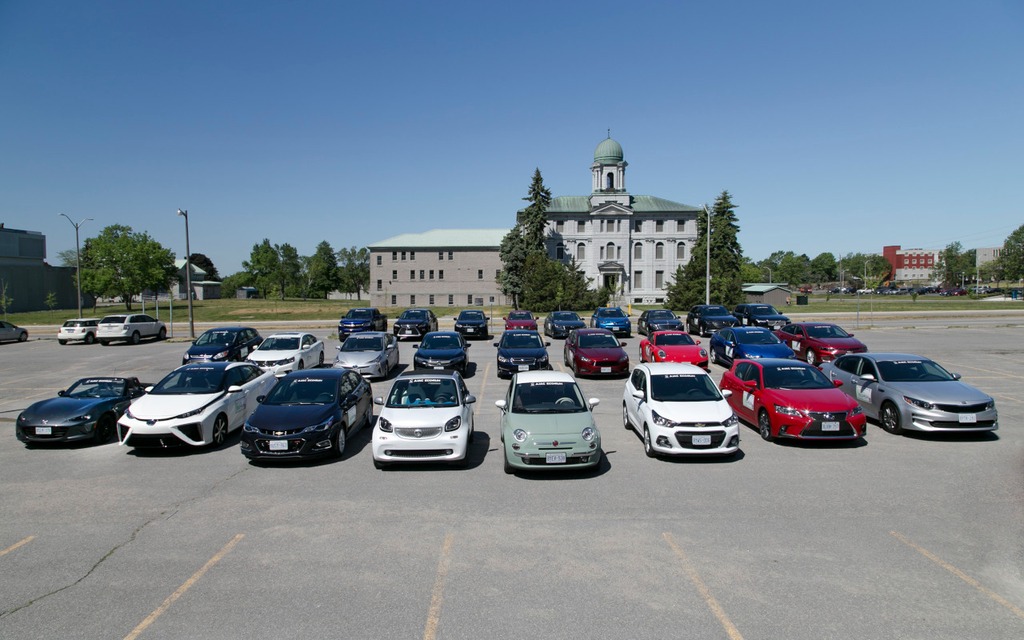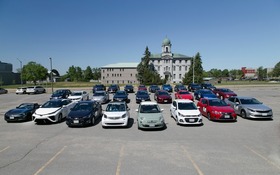AJAC’s 2016 EcoRun: When Automobile Journalists Go Green
Read a few of the articles written by members of the Automobile Journalists Association of Canada and you’ll quickly realize that a good number of us are drawn to thrilling acceleration times and sporty driving—two things that are incompatible with fuel efficiency. But once a year, a gang of AJAC writers get together for a few days of environmentally friendly driving.
AJAC’s EcoRun event aims to prove that a little effort goes a long way in reducing fuel consumption. This year marked the 5th edition of EcoRun and 27 journalists completed the Toronto–Ottawa trip in two days and seven steps. Each segment was carefully planned with a route that included city, suburb and highway.
The instructions to participants stated that hypermiling was to be avoided as a means of lowering fuel consumption because it can often lead to excessively slow and dangerous driving. They also clarified that speed limits were to be observed along with the basic principles of eco-friendly driving (i.e. refraining from sudden accelerations or needless braking).
My experience in six steps
Since there were 27 vehicles and eight steps (seven official ones), I only got the chance to drive eight vehicles, each very different from the other. So here’s a summary of my personal EcoRun experience.
Step 1: Toronto Airport Sandman Hotel to Evergreen Brickworks
Vehicle: 2016 Mazda CX-9
Distance: 35.2 km
Our departure from the hotel was set for 6:45 a.m. to give us a head start on the insane traffic that plagues the Greater Toronto Area. It’s not easy to navigate congestion on the 401 using green driving techniques. Nonetheless, it went pretty well right up to the second-last turn, where I chose the wrong direction. After a long detour, I made it to my final destination, a brick-making plant converted into an environmental centre. I managed to record 7.6 L/100 km, but once my trajectory got off track, it climbed to 8.1 L/100 km.
These are some very good figures for the Mazda CX-9, whose engine is quite efficient given the vehicle’s size.
Observed fuel consumption: 8.1 L/100 km
Advertised fuel consumption: 11.2 L/100 km
--------------------
Step 2: Evergreen Brickworks to the University of Ontario Institute of Technology
Vehicle: 2016 Toyota Prius
Distance: 61.0 km
The purpose of the first step was to bring us to a place where electric and plug-in hybrid vehicles could recharge for the official departure. This time, the distance would be longer, but it would once again include a section of Highway 401 East. We would then drive through some suburban areas east of the big city.
While I was there, I saw one of the world’s most powerful climatic wind tunnels. Our vehicles were charged as we enjoyed some lunch. The Prius stands out for its fuel economy and display system that makes charge levels easy to check.
Observed fuel consumption: 3.1 L/100 km
Advertised fuel consumption: 4.5 L/100 km
--------------------
Step 3: University of Ontario Institute of Technology to Cobourg
Vehicle: 2016 Chevrolet Spark
Distance: 68.3 km
This was definitely the easiest portion of the two-day trek. After accessing the 401 East, we turned off the highway toward Cobourg, a great city with a nicely developed pleasure boating port. This was a nice spot to break for a few hours as the electric vehicles in our fleet charged. The Spark allowed us once again to beat the posted fuel consumption rates quite substantially.
Observed fuel consumption: 5.1 L/100 km
Advertised fuel consumption: 6.7 L/100 km
--------------------
Step 4: Cobourg to Belleville
Vehicle: 2016 Subaru Impreza
Distance: 90.3 km
For the last official step of the day, we took several secondary roads on route to Belleville, where we stayed the night. Even though it’s impressively good on gas, the Impreza has an annoying information centre with hard-to-read numbers.
Observed fuel consumption: 5.2 L/100 km
Advertised fuel consumption: 7.5 L/100 km
--------------------
Unofficial Step: Belleville – Mustang Drive-in Cinema in Picton – Belleville
Vehicle: 2016 Chevrolet Malibu Hybrid
Distance: 40.0 km
This step doesn’t officially count for EcoRun, but for me it was an opportunity to drive this hybrid midsize vehicle. The fuel economy numbers we recorded were lower than the official numbers, despite the fact that we didn’t make any special efforts. I really enjoyed driving the Malibu Hybrid, which seemed to be a rock-solid ride.
Observed fuel consumption: 5.0 L/100 km
Advertised fuel consumption: 5.1 L/100 km
--------------------
Step 5: Belleville to Kingston
Vehicle: 2016 Lexus CT 200h
Distance: 83.9 km
Almost no highway this time, just secondary roads in excellent condition to takes us through a number of municipalities. This Lexus is more luxurious than the Prius we drove before it, but its drivetrain isn’t as recent. Its fuel economy is very good, but this aspect also falls short of the Prius. In Kingston, I seized the opportunity to visit Canada’s Penitentiary Museum.
Observed fuel consumption: 3.8 L/100 km
Advertised fuel consumption: 5.7 L/100 km
--------------------
Step 6: Kingston to Brockville
Vehicle: 2016 Chevrolet Colorado Duramax Diesel
Distance: 84.4 km
This portion once again brought us onto Highway 401 East for several kilometres and then directed us to Brockville, which is along the Saint Lawrence River. We took a long break here to recharge our batteries and fill our stomachs. The Colorado is powered by an extremely quiet diesel engine whose observed fuel consumption was nearly half the advertised rate.
Observed fuel consumption: 6.4 L/100 km
Advertised fuel consumption: 12.0 L/100 km
--------------------
Step 7: Brockville to Ottawa
Vehicle: 2016 Nissan Altima
Distance: 113.0 km
This was the last of the official steps. Unlike most of the other vehicles I drove at EcoRun, the Altima made it impossible for me to get a significantly lower fuel economy rate than the advertised figure. Or was it just me? Not only that, but the fuel economy indicator was hard to read. That said, the navigation system was easy to use, which came in handy when I wanted to find City Hall in downtown Ottawa.
Observed fuel consumption: 7.1 L/100 km
Advertised fuel consumption: 7.5 L/100 km
Impressive results
By the end of EcoRun, the vehicles and drivers had once again succeeded in reducing the advertised combined fuel economy rates by 40%. And remember, that’s without any hypermiling. All we had to do was take it easy and stay within the posted speed limits. I’m looking forward to doing it all again next year.
| Nat. Res. Canada Rate | EcoRun Rate | |
|---|---|---|
| Chevrolet Colorado Diesel | 10.3 | 7.1 |
| Chevrolet Cruze | 6.8 | 4.9 |
| Chevrolet Malibu Hybrid | 5.1 | 4.4 |
| Chevrolet Spark | 6.7 | 5.4 |
| Chevrolet Volt | 5.6 | 0.0 |
| Fiat 500 | 7.9 | 6.3 |
| Ford C-Max Energi Plug In | 6.0 | 4.0 |
| Ford Focus 1 l | 7.3 | 5.8 |
| Honda Civic berline | 6.7 | 4.6 |
| Honda HR-V | 7.6 | 5.9 |
| Hyundai Sonata Plug In | 5.9 | 3.8 |
| Kia Optima LX ECO | 7.4 | 5.6 |
| Lexus CT 200 h | 5.7 | 4.2 |
| Lexus a RX 450 h | 8.0 | 7.1 |
| Mazda CX-3 AWD | 8.1 | 6.4 |
| Mazda CX-9 AWD | 10.1 | 7.8 |
| Mazda MX-5 | 7.8 | 5.3 |
| Mercedes Benz S550 Plug In | 9.0 | 7.3 |
| Nissan Altima 2.5 | 7.5 | 6.3 |
| Nissan Leaf | 2.1 | 0.0 |
| Porsche 911 Carrera | 10.1 | 7.8 |
| Smart ForTwo Cabrio | 6.9 | 4.1 |
| Subaru Impreza | 7.6 | 6.1 |
| Toyota Mirai Pile Combustible | 3.5 | 0.0 |
| Toyota Prius | 4.5 | 3.2 |
| Toyota Rav4 Hybrid | 7.2 | 5.7 |
| Volvo XC90 T8 | 9.5 | 6.9 |











